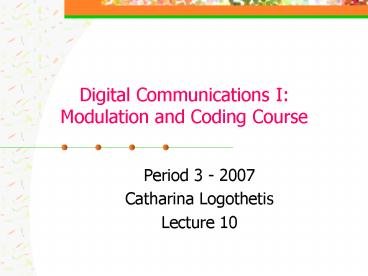Digital Communications I: Modulation and Coding Course - PowerPoint PPT Presentation
1 / 20
Title:
Digital Communications I: Modulation and Coding Course
Description:
Modulation and Coding Course ... Block codes are based on algebraic/combinatorial techniques. Convolutional codes are based on construction techniques. – PowerPoint PPT presentation
Number of Views:345
Avg rating:3.0/5.0
Title: Digital Communications I: Modulation and Coding Course
1
Digital Communications IModulation and Coding
Course
- Period 3 - 2007
- Catharina Logothetis
- Lecture 10
2
Last time, we talked about
- Channel coding
- Linear block codes
- The error detection and correction capability
- Encoding and decoding
- Hamming codes
- Cyclic codes
3
Today, we are going to talk about
- Another class of linear codes, known as
Convolutional codes. - We study the structure of the encoder.
- We study different ways for representing the
encoder.
4
Convolutional codes
- Convolutional codes offer an approach to error
control coding substantially different from that
of block codes. - A convolutional encoder
- encodes the entire data stream, into a single
codeword. - does not need to segment the data stream into
blocks of fixed size (Convolutional codes are
often forced to block structure by periodic
truncation). - is a machine with memory.
- This fundamental difference in approach imparts a
different nature to the design and evaluation of
the code. - Block codes are based on algebraic/combinatorial
techniques. - Convolutional codes are based on construction
techniques.
5
Convolutional codes-contd
- A Convolutional code is specified by three
parameters or where - is the coding rate, determining the
number of data bits per coded bit. - In practice, usually k1 is chosen and we assume
that from now on. - K is the constraint length of the encoder a where
the encoder has K-1 memory elements. - There is different definitions in literatures for
constraint length.
6
Block diagram of the DCS
Information source
Rate 1/n Conv. encoder
Modulator
Channel
Information sink
Rate 1/n Conv. decoder
Demodulator
7
A Rate ½ Convolutional encoder
- Convolutional encoder (rate ½, K3)
- 3 shift-registers where the first one takes the
incoming data bit and the rest, form the memory
of the encoder.
(Branch word)
8
A Rate ½ Convolutional encoder
Message sequence
Time
Output
Output
Time
(Branch word)
(Branch word)
9
A Rate ½ Convolutional encoder
Encoder
10
Effective code rate
- Initialize the memory before encoding the first
bit (all-zero) - Clear out the memory after encoding the last bit
(all-zero) - Hence, a tail of zero-bits is appended to data
bits. - Effective code rate
- L is the number of data bits and k1 is assumed
Encoder
data
codeword
tail
11
Encoder representation
- Vector representation
- We define n binary vector with K elements (one
vector for each modulo-2 adder). The ith element
in each vector, is 1 if the ith stage in the
shift register is connected to the corresponding
modulo-2 adder, and 0 otherwise. - Example
12
Encoder representation contd
- Impulse response representaiton
- The response of encoder to a single one bit
that goes through it. - Example
Branch word
Register contents
13
Encoder representation contd
- Polynomial representation
- We define n generator polynomials, one for each
modulo-2 adder. Each polynomial is of degree K-1
or less and describes the connection of the shift
registers to the corresponding modulo-2 adder. - Example
- The output sequence is found as follows
14
Encoder representation contd
- In more details
15
State diagram
- A finite-state machine only encounters a finite
number of states. - State of a machine the smallest amount of
information that, together with a current input
to the machine, can predict the output of the
machine. - In a Convolutional encoder, the state is
represented by the content of the memory. - Hence, there are states.
16
State diagram contd
- A state diagram is a way to represent the
encoder. - A state diagram contains all the states and all
possible transitions between them. - Only two transitions initiating from a state
- Only two transitions ending up in a state
17
State diagram contd
0/00
Output (Branch word)
Input
00
1/11
0/11
1/00
10
01
0/10
1/01
0/01
11
1/10
18
Trellis contd
- Trellis diagram is an extension of the state
diagram that shows the passage of time. - Example of a section of trellis for the rate ½
code
State
0/00
1/10
Time
19
Trellis contd
- A trellis diagram for the example code
20
Trellis contd
Tail bits
Input bits
Output bits
0/00
0/00
0/00
0/00
1/11
1/11
0/11
0/11
0/10
0/10
1/01
0/01































